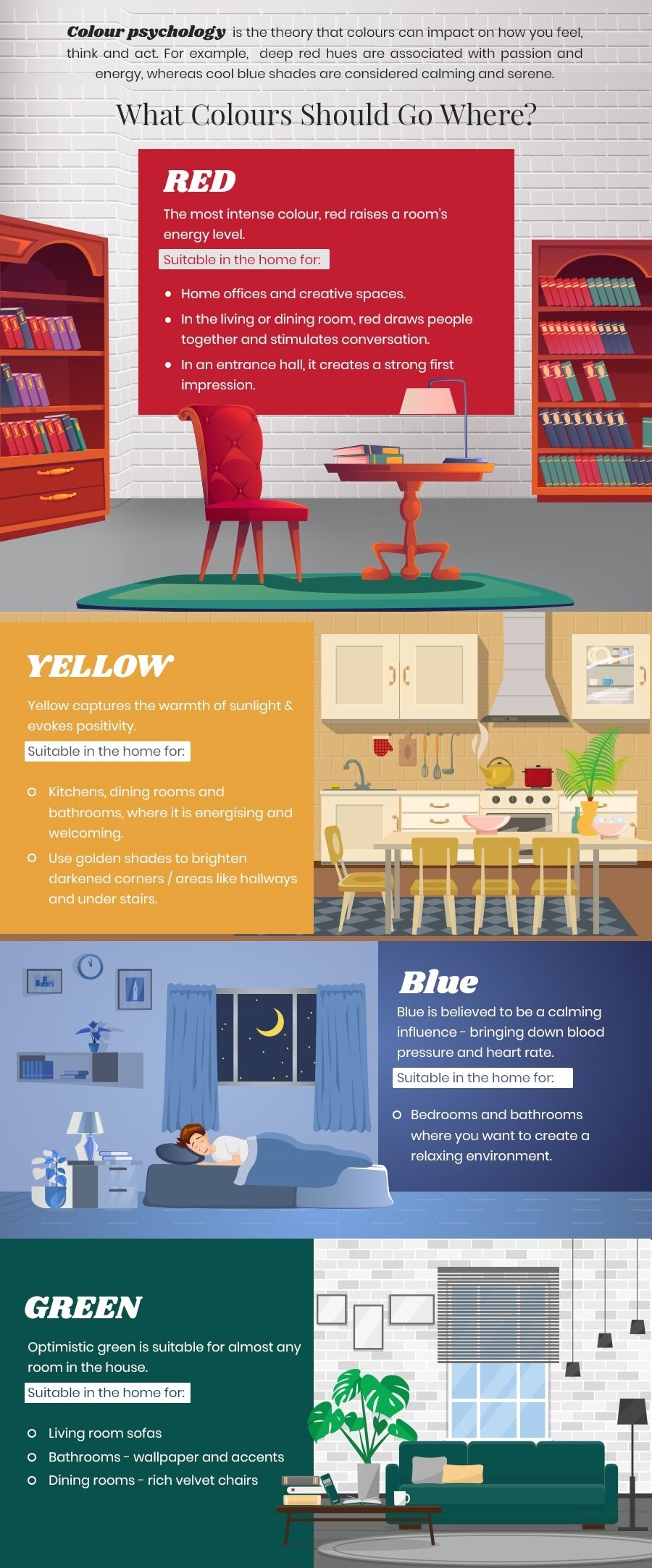Psychology of Room Color in Design – Mood, Feelings, Comfort [INFOGRAPHIC]
Do we take room color in design for granted? Is the color of a room so elemental that we rarely consider it in detail? Are there certain colors that belong in certain rooms, while others should never be used there? (Or anywhere?)
These questions came to mind recently when we received a promotional email from a furniture manufacturer based in Ireland. In the message, we were asked to consider “Colour Psychology in Interior Décor”. (Yeah, the “ou” in colour tells a whole ‘nother story. Posh, much?)
Before we go there though; that is, into how specific colors affect moods, emotions, and comfort levels in the spaces they’re used, we found ourselves attracted to their 60-30-10 Colour Rule for Timeless Decorating.
As they explain, the Rule is designed to ensure the colors used in any space are in proportion, and that they offer balance when used this way. The breakdown makes sense, with the Main color (60%), Secondary color (30%), and the Accent color (10%).
-
Main color – In a living room, for example, this would include wall color, rugs and/or carpeting, as well as the central piece of furniture, perhaps a sofa or sectional (which are making a huge comeback, BTW). This way, your 60% color becomes the foundational emphasis of the space.
-
Secondary color – Use half as much of this color, relative to your Main color. Choices for your Secondary color here include curtains, accent chairs, painted furniture, bed linens, or an accent wall. The choices you make with this color will enhance and support your Main color while keeping the space interesting and distinct.
-
Accent colors – Using a living room again, your 10% color may be found on lamps, cushions, accessories, and wall art. In a bedroom, this might be accented with a throw on the bed, lamps, and decorative pillows and comforters. Again, your goal with Accent colors is to make a space unique, and uniquely balanced, in color choices.
Balance… Comfort… Pleasure… Belonging… Home… These are the qualities a homeowner seeks from their interior designer. The balanced use of color in each space makes all of them possible for you to give them.
Psychological Impact of Colors
While the majority of human beings have an intuitive understanding of the power of colors to affect moods, many researchers refuse to accept intuition or anecdotal evidence as proof (of anything). They want data and, for them, skepticism reigns supreme.
However, according to an article on the mental health website Very Well Mind, “While perceptions of color are somewhat subjective, there are some color effects that have universal meaning.
“Colors in the red area of the color spectrum are known as warm colors and include red, orange, and yellow. These warm colors evoke emotions ranging from feelings of warmth and comfort to feelings of anger and hostility.
“Colors on the blue side of the spectrum are known as cool colors and include blue, purple, and green. These colors are often described as calm, but can also call to mind feelings of sadness or indifference.”
Does Proof Exist?
As an interior designer, whether through intuition or education, you likely understand the emotional impact of colors in rooms and furnishings. For example, and from Very Well Mind again, “The connection between colors and emotions have established color choice as a kind of science. Environmental psychologist Lee Chambers, PsyM says that color associations are extremely important, even in workplaces.
“He explains, ‘I explore how color can be used to promote productivity and well-being in a work environment. From a psychological perspective, it is clear that an individual's cultural appreciation of color and personal preference can influence the effect of the color on their mood.’
“From a psychological perspective, it is clear that an individual's cultural appreciation of color and personal preference can influence the effect of the color on their mood.
“It makes sense that red can provoke positive and negative emotions since it signifies love and passion, as well as danger and anger. Based on his observations, Chambers reports, ‘A red environment was highly stimulating and created a level of energy which increased agitation and volatility, leaving one employee referencing the fact that the red wall made him feel aggressive’.
“Chambers also reports that yellow can boost creativity and learning, but fatigue the eyes after a while. He also explains that shades of green are common in his work. ‘Green environments are a large part of my work and encompassing nature in the workplace is a significant driver. We can see more shades of green than any other color.’ This is most likely because of the reported feeling of growth and regeneration.”
While the mood-altering effects of color may be temporary, our intuitive understanding of the power of colors to affect our moods cannot be denied. When you add personal experience to that, the negative evaluations of the so-called “experts” quickly fades.
Ted remains available to work with you on an individual basis, consulting on how your design business can best employ the psychological impact of room color in design to make your clients happy. Get in touch with TD Fall today.


